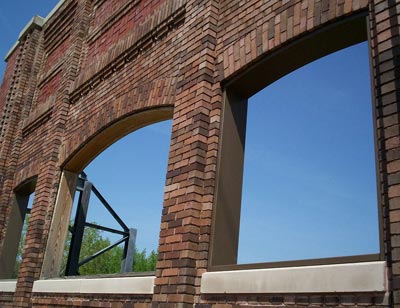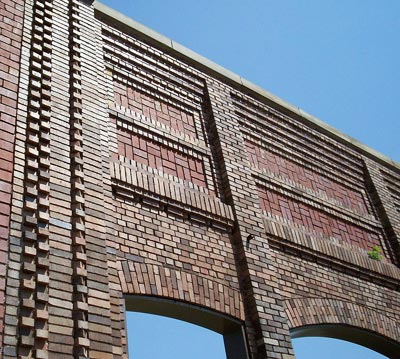League Park had produced many noted performances since that first game on May 1, 1891. Although the park was actually Cleveland's fourth professional playing facility (the Cleveland Forest Citys had performed on various fields since 1869), it can easily be argued that there never was, nor has there been since, a finer one.
There were over 9,000 fans in attendance that afternoon to watch baseball's most revered pitcher, Cy Young, pitch the Cleveland Spiders ( its nickname due to the many tall, skinny players) to a 12-3 decision over the Cincinnati Red Stockings.
In those days, ladies were admitted free to the park except on Saturdays and holidays, and ticket prices ranged from 25 cents to $1. 25. No games were played on Sundays here, it was illegal in Ohio.
The games were quite wild in the early days of League Park. There was only one umpire for games, and he positioned himself behind the pitcher. Thus, while the umpire concentrated on the action in front of him, it was not uncommon to see a baserunner taking a shortcut from first to third (skipping second base completely) or to observe an infielder "misplace" his foot in the pathway of an oncoming runner to delay his momentum.
Many games ended in riots or protests. The game had character back then.

The Cleveland franchise first tasted success during the 1892 season when the Spiders performed well enough to encounter the Boston Beaneaters in a best-of-nine playoff dubbed "The World Series" by the media.
In front of 6,000 fans, the Cy Young-led Spiders battled the Beaneaters to an 11-inning, scoreless tie in game one before it was called because of darkness. That was as well as the Spiders would play: the powerful Beaneaters swept Cleveland in five games to become champions.
Just three years later, the Spiders became the champions themselves, led by Young's pitching and the .423 batting average of Jesse Burkett. The Baltimore Orioles were the victims, and the Temple Cup trophy became the pride of Cleveland.
The happiness was short-lived, however, as club owner Frank DeHaas Robinson began to disperse the team's talent due to decreasing attendance at League Park. Robinson had acquired the St. Louis franchise and stars such as Young and Burkett were sent to perform there.
The outraged fans boycotted League Park to such an extent that the 1898 Spiders were forced to play all of their games on the road. With the worst record ever recorded in baseball history -- 20 victories and 134 defeats -- the team soon became known as the "Misfits."
From 1900 to 1902, the team was named the Cleveland Blues (partly due to their performances but mostly because of their uniform colors) and League Park remained relatively unattended. Things would soon change.
While spending the 1902 season under the tag "Broncos" (Cleveland players wanted a more forceful nickname), the franchise took a turn for the better. Charley Somers, who had obtained the team in 1900 after helping save the Chicago, Boston, Philadelphia, and St. Louis franchises obtained Napoleon Lajoie from the Philadelphia Athletics.
The scrappy, star second baseman led the team through some exciting seasons during his years here, and although Cleveland won no championships while he played, he put fans back in League Park once again. It was no surprise then, the Cleveland franchise changed its name to the "Naps" from 1903 to 1914 in a tribute to the future Hall of Famer.
One of the greatest pitching performances in League Park history was turned in during the Lajoie days as in 1908 Cleveland's Addie Joss hurled the sport's fourth perfect game against the Chicago White Sox while in a hotly contested pennant race.
As Cleveland baseball interest soared, team owners decided to give League Park a facelift of sorts. Among the 1910 expansion moves were increased seating (from 19,200 to about 23,000), a steel and concrete base for the park (the original wood was a fire hazard), and the moving of homeplate 30 feet closer to the outfield wall.

Since League Park was bounded on four sides by neighborhood houses, the seating capacity was expanded with a second level. In so doing, the park preserved its image: "didn't have a bad seat in the house."
On April 21, 1910, the new League Park was ready. Unfortunately, the Naps were not and the Detroit Tigers handed them a 5-0 setback before 19,867 fans.
Perhaps one of the greatest single games ever played at League Park took place on July 24, 1911. Baseball's first all-star game was staged between the Naps and some of the true immortals of baseball history. Ty Cobb, Tris Speaker, Eddie Collins, Sam "Home Run" Baker, and Walter Johnson were just some of the visitors who helped the all-stars defeat the Naps 5-3 that afternoon.
The 1914 season was to be a sad one for Cleveland fans. The team finished in last place for the first time in over a decade and Lajoie was released.
The conclusion of League park - Cleveland Indians, Tris Speaker and the 1920 Series - in Part 3
Top of Page
Back to Memories for Cleveland Seniors
Back to Cleveland Sports
Part 3 of League Park